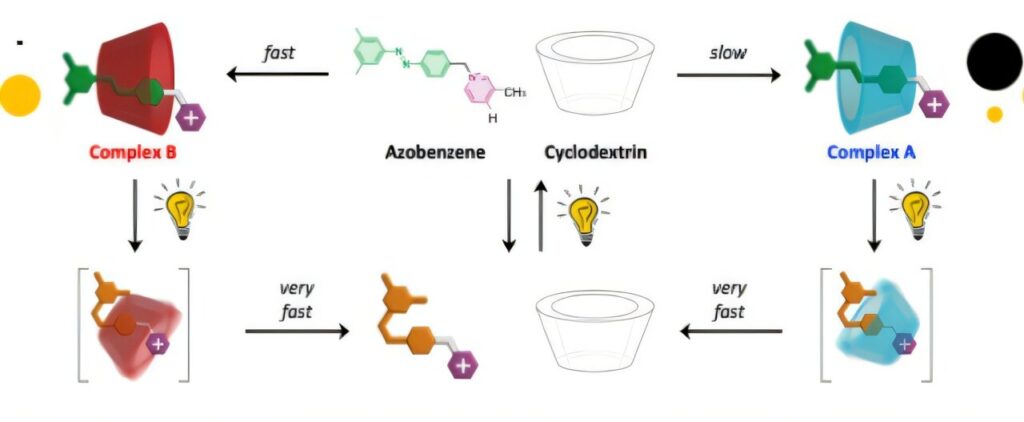Exploiting an ingenious combination of photochemical (i.e., light-induced) reactions and self-assembly processes, a team led by Prof. Alberto Credi of the University of Bologna has succeeded in inserting a filiform molecule into the cavity of a ring-shaped molecule, according to a high-energy geometry that is not possible at thermodynamic equilibrium. In other words, light makes it possible to create a molecular “fit” that would otherwise be inaccessible.
“We have shown that by administering light energy to an aqueous solution, a molecular self-assembly reaction can be prevented from reaching a thermodynamic minimum, resulting in a product distribution that does not correspond to that observed at equilibrium,” says Alberto Credi.
“Such a behavior, which is at the root of many functions in living organisms, is poorly explored in artificial molecules because it is very difficult to plan and observe. The simplicity and versatility of our approach, together with the fact that visible light—i.e., sunlight—is a clean and sustainable energy source, allow us to foresee developments in various areas of technology and medicine.”
The study was published in the journal Chem
The self-assembly of molecular components to obtain systems and materials with structures on the nanometer scale is one of the basic processes of nanotechnology. It takes advantage of the tendency of molecules to evolve to reach a state of thermodynamic equilibrium, that is, of minimum energy.
However, living things function by chemical transformations that occur away from thermodynamic equilibrium and can only occur by providing external energy.
Reproducing such mechanisms with artificial systems is a complex and ambitious challenge that, if met, could enable the creation of new substances, capable of responding to stimuli and interacting with the environment, which could be used to develop, for example, smart drugs and active materials.
The molecular fit
The interlocking components are cyclodextrins, hollow water-soluble molecules with a truncated cone shape, and azobenzene derivatives, molecules that change shape under the effect of light. In water, interactions between these components lead to the formation of supramolecular complexes in which the filiform azobenzene species is inserted into the cyclodextrin cavity.
In this study, the filiform compound possesses two different ends; since the two rims of the cyclodextrin are also different, insertion of the former into the latter generates two distinct complexes, which differ in the relative orientation of the two components.
Complex A is more stable than complex B, but the latter forms more rapidly than the former. In the absence of light, only the thermodynamically favored complex, namely A, is observed at equilibrium.
By irradiating the solution with visible light, the azobenzene changes from an extended configuration akin to cyclodextrin to a bent one incompatible with the cavity; as a result, the complex dissociates. However, the same light can convert the azobenzene back from the bent to the extended form, and the dissociated components can reassemble.
Because complex B forms much faster than A, under continuous illumination a steady state is reached in which complex B is the dominant product. Once the light is turned off, the azobenzene slowly reverts to the extended form, and after some time only the A complex is observed.
This self-assembly mechanism coupled with a photochemical reaction makes it possible to harness the energy of light to accumulate unstable products, thus paving the way for new methodologies of chemical synthesis and the development of dynamic molecular materials and devices (e.g., nanomotors) that operate under non-equilibrium conditions, similar to living beings.
The study is the result of a collaboration between the Departments of Industrial Chemistry “Toso Montanari,” Chemistry “Ciamician” and Agricultural and Food Science and Technology of the Alma Mater, the University of Coruña in Spain and the Isof-Cnr institute in Bologna.


